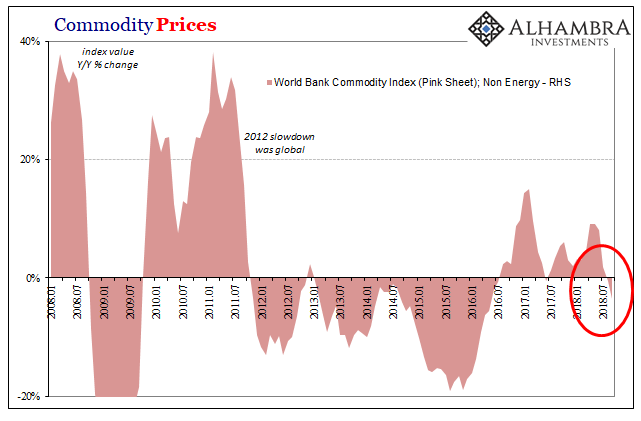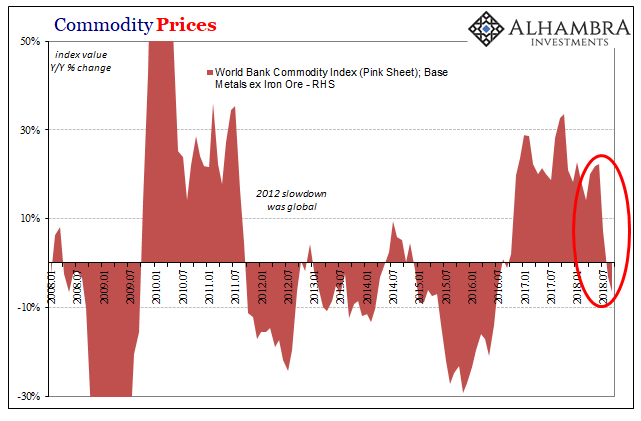How Close Are the Clouds?
April was only a half a year ago, the optimism of 2017 at that time as yet untroubled by darkening skies. What had happened earlier in the year was nothing, they said, just a little nervousness about things becoming, don’t laugh, too good. Inflation was picking up because the global economy was roaring, which would require more aggressive action on the part of the Federal Reserve if not others.
These were, or would have been, very good problems to have after the last decade.

Importantly, commodity prices weren’t really buying it. They were up off the 2016 lows, but that was an incredibly low standard, a throwaway comparison. Far too many remained well below their 2011 post-crisis highs, which was a warning that investors were being as cautious as optimistic. There was a lot of initial enthusiasm at the start of Reflation #3 in the second half of 2016, but it didn’t follow through.
Commodities were signaling throughout last year that maybe everyone had gotten a little ahead of themselves on this globally synchronized growth business. Economists, however, were having none of that. They surmised that pessimism was, as always in their view, irrational. Over time commodity prices would have to reflect this looming economic boom.
Thus, when confronted by “unusual” activity at the start of 2018 it was dismissed. The World Bank in its April 2018 Commodity Markets Outlook predicted:
More than half of commodity prices (and all non-coal energy prices) are expected to increase in 2018 but four-fifths of them will remain below their 2011 peaks…Non-energy prices are projected to gain more than 4 percent in 2018 before they stabilize in 2019.Between then and now emerging markets were massacred, a resurrected “rising dollar”. In eurodollar terms, meaning the world’s actual global reserve currency, deflation.
Assessing global economic opportunities in the face of tightening global money, commodity markets through September have reversed. Non-energy prices, according to the World Bank’s Commodity Index (Pink Sheet), fell slightly year-over-year in August and then accelerated to -3.7% in September. It was the steepest decline since, obviously, the last rising dollar period.

In terms of base metals (excluding iron ore), the dramatic shift is all the more alarming.

Between 2011 and 2017, there was that obvious deflationary wave that had developed in the wake of the eurodollar’s last stand. Outside of very minor reflation in 2014, it was a rough time for physical commodities as a reflection of economic conditions (in reality as opposed to mainstream commentary) especially in Asia and EM’s, China most of all....MUCH MORE
Since commodities tend to be leading indicators, the major change in momentum indicated above, similar in intensity and suddenness to the latter part of 2011, wouldn’t appear to indicate anything good about the future direction of the global economy.
The Chinese reported today, relatedly, slowing import growth in the month of September 2018. While exports were slightly better than they had been the past six months, +14.5% year-over-year, imports were especially weaker. Rising just 14.3% year-over-year last month, that’s the second time in the last four months with less than 15% growth....